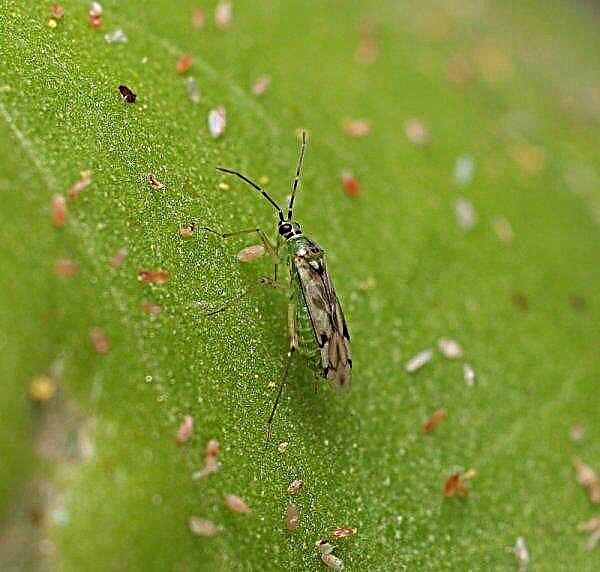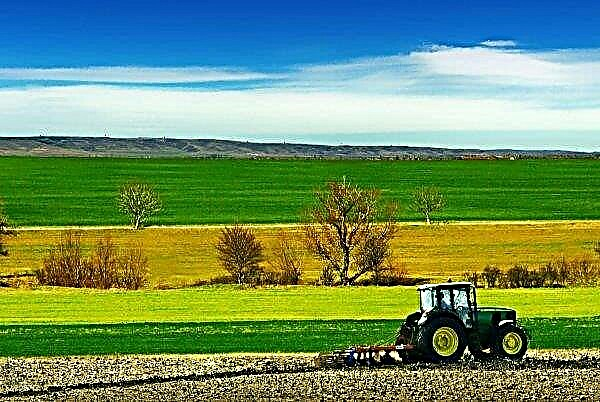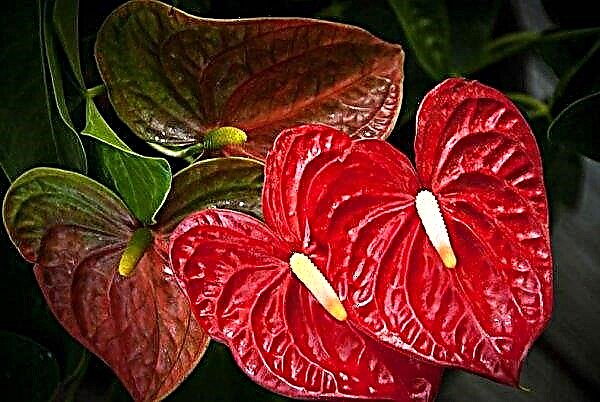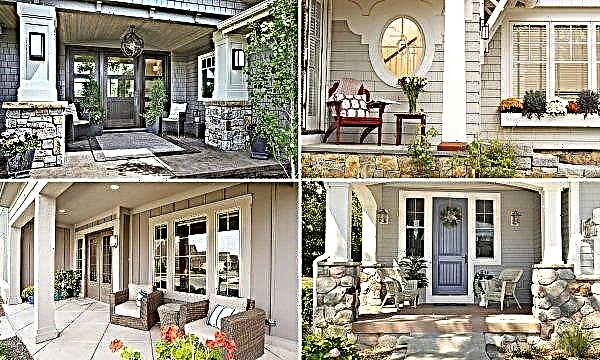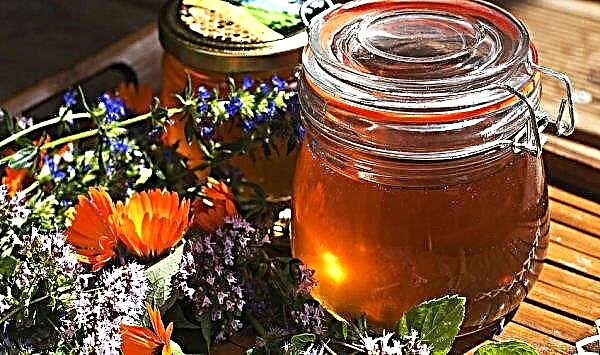When designing their site or garden, each person chooses the type of plants and decorations to his taste. But there are several basic styles of landscape design, each of which has its own characteristics and characteristics. A detailed description and the main features of each of them are briefly listed later in the article.
English style
This style of park design is also called landscape. It promotes the careful attitude of man to the objects of nature. The main feature of this style is the combination of negligence, naturalness of the arrangement of all the constituent elements with the well-groomed area.
Did you know? The ancient Greeks in the 10th century were engaged in landscape design. BC e. In addition to plants, they used to equip the site with statues and columns.
The characteristic features of the English style:
- all lines are smooth and curved, without sharp protrusions;
- the house is an integral part of the overall design of the site;
- the use of climbing plants and vines for vertical gardening;
- the paths are paved with stone slabs, cobblestones or bricks;
- benches, flowerpots, statues, arbors made of stone and wood;
- neat green lawns;
- living corridors formed by plants and shrubs of various heights;
- the presence of antique objects, wrought iron fences and lanterns, handicrafts;
- bright and contrasting flower beds made in the form of a carpet or a hill;
- a large number of perennials;
- artificially equipped pond or stream with a small bridge;
- an abundance of roses, poppies, mallow, begonias, colorful delphinium in lush flower beds.
Dutch
The main highlight of this style of garden design is the exemplary landscape, as well as the variety of bright colors. At the same time, the entire territory has a well-groomed appearance and is open for public viewing.
Important! Lamps and lanterns on the site should be located so that the light from them fell from the side of the observer, and not blind him.
The main features of the Dutch style:
- the central decorative element is a lawn surrounded by blooming flower beds and shrubs;
- instead of a standard fence there is a forged fence or a small hedge of juniper, boxwood;
- in the center of the lawn there is a small tree, a fountain;
- the plot is dominated by flowers and compact shrubs, very few trees;
- flower beds are located along the paths and are colorful compositions;
- flower beds consist of crocuses, tulips, hyacinths, lilies, daffodils, delphinium;
- the design uses small funny stone statues - animals, fairy-tale characters;
- flower beds are broken not only on the ground, but also in decorative carts, suitcases, chests of drawers;
- garden paths are sprinkled with pebbles or wood chips;
- additional decor elements are installed on separate sites;
- benches are embedded in hedges;
- there are elements of a rustic decor - small wells, mills, wooden wheels and buckets.

Country (rustic)
This style is one of the oldest, and its main idea is simplicity, ease and naturalness. In this case, the gardener can show complete freedom of creativity during the arrangement of the site, creating a cozy place that looks like a modest rural life.
The main distinguishing features of country style:
- carelessness and randomness of the placement of objects, flower beds;
- winding garden paths made of gravel or stone slabs with grass sprouted between them;
- a large number of fruit trees located in different corners of the site;
- compact beds with vegetables, garden crops;
- landscaping fencing with climbing plants;
- handmade wooden or wicker furniture, small swings;
- the presence of flowers growing outside the decorated flower beds;
- the use of rustic decor items - wicker fences, carts, wooden wheels, earthenware, baskets, barrels, garden scarecrows;
- the presence of decorative compositions from fruits and berries;
- compositions from field and garden plants - daisies, calendula, sunflowers, mallow, ferns, clovers;
- clay or wooden figures of animals and birds.

Chinese
This direction is based on the laws of Feng Shui. At the same time, all objects should be placed so that the qi energy generated as a result of the movement of water and wind freely and correctly circulates around the site.
Did you know? In the 1st century in ancient Rome, hedges, fountains and grottoes were first used to decorate the territory.
Characteristics of the Chinese style:
- lack of strict symmetry and right angles;
- combining all objects into completed compositions;
- the presence of shady places for meditation;
- creating an impression of the infinity of the site due to changing landscapes;
- a pond with still water, as well as streams, fountains, small waterfalls with compact bridges thrown over them;
- decorative tea gazebo with a curved roof, located on a hill in a secluded area;
- the presence of compositions and small hills of stones of unusual shapes, boulders;
- wooden gate at the entrance;
- fence around the site, repeating all contours of the relief;
- flower beds of roses, dahlias, irises, peonies, jasmine and chrysanthemums;
- moderate number of trees (peach, willow, plum, bamboo, pine).

Mauritanian
This style of landscape design is also called oriental or Muslim, and its distinctive feature is luxury and splendor of design. The site becomes like a fabulous oasis intended for relaxation, filled with pleasant sounds, bright colors and aromas.
The main features of the Moorish style:
- isolation of the territory from the outside world with the help of a stone fence installed around the perimeter;
- planning according to the chor-tank principle - visual division of the site into 4 equal squares, delimited by hedges or garden paths;
- the presence of symmetrical lines, regular geometric shapes;
- pools and fountains with Arabic mosaics in each of the four squares of the garden;
- a large number of fruit trees and flowering shrubs exuding a sweet aroma - peaches, jasmine, quince;
- round or square flower beds with fragrant herbs, bright colors;
- recreation areas in shady places - sunbeds, couches, gazebos and tents with many pillows;
- multi-colored compositions of tulips, hyacinths, lilies and roses;
- the presence of bright or songbirds - peacocks, parrots and canaries in suspended cages.

Japanese
This style of landscape design is sometimes confused with Chinese, but it has its own distinctive features. On such a site, all objects symbolize certain elements, expressing yin and yang, and the garden itself is a territory for contemplating nature.
Important! In order to visually expand the borders of a rectangular section, a decorative object is installed in each of the corners or a bright flowerbed is organized.
The main features of the Japanese style:
- asymmetry of lines and shapes;
- the presence of several separate zones interconnected;
- the use of pines, maples, cherries, plums, thuja and juniper for single and group plantings;
- strong walls surrounding the site on all sides;
- a large number of stones of various sizes, arranged in groups and separately;
- the crowns of trees neatly trimmed in the form of hills;
- the lack of bright colors, the predominance of monophonic color;
- motionless reservoirs - ponds, large bowls of stone;
- gurgling fountains, “dry” streams with curved bridges thrown over them;
- narrow paths paved with flat stone slabs;
- the abundance of moss, ferns and evergreens;
- stone and wooden benches with a rough appearance;
- Japanese lanterns on tree branches;
- internal fences, arches and gates from bamboo stalks;
- decorative tea gazebo;
- flower beds from peonies, irises, cereal plants.

Colonial
The colonial-style plot is not only a place to relax, but also a source of fruit. At its arrangement simple materials are used, and the placement of objects is based on the idea of practicality.
The main features of the colonial style:
- division of space into separate zones - agricultural buildings, an orchard and beds with garden crops;
- low white wooden fences that define the boundaries of each zone;
- narrow and straight garden paths covered with wood flooring or wood chips
- small figures of wood, stone or ceramics in the form of rabbits, ducks, angels;
- terrace or veranda, entwined with hops, ivy;
- compact fountain located near the veranda;
- forged arches and decorative arbors;
- mobile flower beds in large flowerpots, tubs and ballot boxes;
- wooden and wicker furniture, a rocking chair or a hanging hammock;
- variegated flowers - daffodils, hyacinths, begonia, phlox, peonies, lilies, hydrangeas;
- the presence of medicinal and edible plants - lemongrass, marjoram, echinacea, saffron;
- variety of fruit trees.

Russian estate
When designing a site in the style of a Russian (noble) estate, they use light shades - pink, light blue, white and cream. Such a garden is intended for a relaxing rest and reflection, and its arrangement requires a fairly large area.
Did you know? The most ancient art of landscape design originated in China about 1 thousand years BC. It harmoniously combines the beauty of nature and the achievements of man.
The main characteristics of the style:
- winding paths without right angles;
- the presence of old and powerful trees with a spreading crown (oak, linden, spruce);
- secluded places of rest located in the shade - arbors, swings, small benches;
- use of old sculptures and statues;
- a small artificial pond or several compact fountains;
- lawns with wild grass, dandelions and clover;
- decorative pavilion or rotunda;
- hedges of low trees, shrubs;
- lush flower beds and flower beds located on the hills;
- wrought-iron gates, lanterns of a classical form along garden paths.
Provence
A feature of this style is the combination of sophistication with the natural roughness characteristic of most small villages in France. The site thus decorated retains its decorative appearance and cozy atmosphere at any time of the year.
The main features of the style:
- a variety of fruit and wild trees - linden, apricot, olive, apple tree;
- the use of stone, sandstone and shell rock as a material for a terrace or decorative steps;
- vertical landscaping of stone walls with ivy, grapes, climbing roses;
- compact beds with Provencal herbs growing on them - lavender, rosemary, mint, thyme;
- antique gazebos and cracked wooden furniture;
- decorative stone well, pool or small fountain;
- narrow stony paths extending in different directions from the main paths paved with ceramic tiles;
- lush flower beds with hydrangeas, delphinium, lupine, lavater.

Italian (Mediterranean)
The plot, decorated in a Mediterranean style, has the appearance of a noble southern resort and is intended for relaxation. Its characteristic feature is light shades, as well as a harmonious combination of stone, plants and water.
Important! Some exotic trees and shrubs cannot be grown in cold climates. When choosing plants and flowers for landscape design, it is necessary to take into account the climatic features of a particular region.
The main features of the Italian style:
- the alternation of shady areas with lawn lit by the sun;
- the central element of the composition is a patio covered with ceramic tiles;
- an abundance of tropical plants and trees growing in large flowerpots and tubs - palm trees, cypress trees, magnolias, acacias, olive trees;
- large pool, fountains from several tiers;
- umbrellas and tents from light canvas;
- pergolas hanging over paths covered with climbing plants;
- decorative objects in the form of antique ruins - columns and porticoes of white color, amphora with flowers;
- a gazebo with flowerpots, located in the shade of trees;
- wide benches, painted white with pillows lying on them;
- bright flower beds consisting of crocuses, hyacinths, lilies, primroses, climbing roses, cereals;
- garden paths and square areas paved with mosaics;
- spacious terraces, wide stairs made of stone;
- compact beds with fragrant Italian herbs - lavender, rosemary, lemon balm.

Alpine
An alpine-style garden plot requires minimal maintenance, but is particularly picturesque. This design method is ideal for embossed areas and involves the use of gray shades in combination with bright colors.
Characteristic features of the style are:
- compositions of stones and boulders of any size;
- the division of the terrain into separate zones with the help of reliefs and rocky podiums;
- the presence of small hills, rocky hills;
- the use of vertical gardening to smooth out transitions between separate zones;
- lack of fences and barriers;
- “Dry” streams and small ponds with stone bridges thrown over them;
- massive containers of square and rectangular shape with flowers - daisies, poppies, violets, bells;
- decorative gazebos with panoramic views of the entire surrounding area;
- compact spiral beds with fragrant herbs located between the stones;
- trees planted individually and in groups - mountain pines, arborvitae, juniper, honeysuckle;
- simple canopies made of wood of small sizes.

Eco style
The second name of this style is Naturgarden. Recently, its popularity has been increasing, because the main idea of the design of the site in this case is the maximum naturalness of the landscape. The territory looks like a separate ecosystem, consisting of interconnected objects.
Did you know? The famous Roman ruler Claudius Caesar, who lived at the beginning of the 1st century. n e., was fond of the art of landscape design. He independently decorated his garden with various varieties of roses and other decorative objects.
The main characteristics of ecostyle:
- only natural materials and plants characteristic of a specific region are used for decoration;
- the true state of the relief is maintained;
- the use of garden flowers in combination with wild plants and stones;
- lawns have a natural look, covered with wild grass;
- garden paths are moderately winding, with bumps and protrusions, intermittently paved with stone tiles;
- the predominance of forest trees and shrubs with a crown of natural form;
- simple and practical furniture made of wood or vines;
- the presence of a decorative hearth made of stone;
- a small pond or swamp surrounded by reeds with a simple wooden bridge;
- the use of decorative snags and stumps of an unusual shape;
- sawn tree trunks are present as benches;
- the presence of bird feeders, decorative beehives or home-made lanterns from bottles suspended on tree branches.

Modern
This style is also known as liberti or art nouveau, with some sophistication and elegance.The garden, arranged in this way, is designed to delight the observer with its luxury, streamlined shapes and contrast of colors, textures, sizes.
The main features of the Art Nouveau style:
- the territory of the garden is structured, there are small architectural forms;
- the central element of the plot is a house in a modern style;
- all lines and bends are smooth, without sharp breaks;
- the decor uses only modern materials - stone, metal, dark wood;
- the plants are arranged in groups, and in the center of each composition there is a spectacular element of an unusual color or appearance (bush with fancy branches, a tree with bright leaves, etc.);
- there are many accents in the territory;
- tall trees are combined with dwarf;
- vertical gardening with wild grapes;
- illuminated areas contrast alternately with shaded;
- flower beds have an asymmetric shape;
- of flowers dominated by lilies, irises, poppies, lilies of the valley, ferns and nasturtiums;
- flower containers and flowerpots with clear contours;
- the use of concrete and terracotta slabs, textured garden parquet with the same pattern in the design of paths and platforms;
- small metal figures of birds, insects;
- forged elements with a vegetable pattern - lattices, gates, fences, lamps, benches.

Minimalism
The main slogan of this style is conciseness and simplicity, and the site looks attractive thanks to expressive and spectacular elements. At registration of the district it is possible to use both natural, and artificial materials of rough invoice.
Characteristic features of the style:
- uneven terrain divide the site into separate zones;
- objects are located separately from each other;
- the presence of stone stairs with triangular or arched steps;
- straight and level paths paved with stone slabs;
- the presence of a reservoir of regular geometric shape;
- the use of mirrors, massive concrete, stone elements;
- strict diode lamps with a striking appearance;
- compact plastic and aluminum furniture;
- instead of lawns, rocky mounds of gravel and gravel are present;
- the use of trees and shrubs with the crown of the correct form - spruce, thuja, juniper, plane trees;
- vertical landscaping using wild grapes, hops;
- small wooden or plastic containers of a cubic or cylindrical shape with bright colors - petunias, asters and chrysanthemums;
- simple arbor, designed in the form of a canopy with a back wall made of wood or hedges.

High tech
Equipped in this style, the site amazes the viewer with a variety of modern decor objects and original designs that are effectively placed on the territory. It is believed that high-tech is intended for busy people, that is, there are practically no flower gardens in the garden, and other plants require minimal care.
Important! Before starting the design of the site, it is recommended to draw up on paper a detailed plan for the location of all objects. This will help to provide an approximate appearance of the garden.
The main features of the style:
- expressiveness and distinctness of forms, the presence of clear angles;
- use of polished stone and wood;
- massive abstract objects and futuristic sculptures made of modern materials - glass, metal;
- the use of low trees with a crown of the correct form - spruce, boxwood, juniper;
- rectilinear or zigzag garden paths covered with colored gravel, concrete or wood tiles;
- evenly trimmed green lawn;
- the use of climbing plants on vertical supports installed throughout the site;
- a reservoir with clear contours surrounded by a stone border;
- straight and level steps on the stairs;
- fixtures and lamps of modern design, providing multi-colored lighting of the territory;
- the presence of massive cubes and balls in live fences of barberry, cotoneaster and hawthorn;
- minimum number of flower beds or their complete absence;
- small groups of ferns, succulents, hosts growing in flowerpots and containers of strict geometric shape;
- arbor in the form of a metal or wooden sphere.
Regular
The second name of this style is classic or formal. It is based on the idea that man acts as the architect of nature, so the proportions are clearly observed in the design of the site. All objects are located rationally and symmetrically, according to a pre-planned layout.
Main features of the regular style:
- straight garden paths arranged symmetrically;
- flower beds and flower beds of regular geometric shape with lilies, tulips and cyclamens planted on them;
- a well-kept rectangular lawn with an antique statue in the center, a fountain or an exquisite floral arrangement;
- small areas bounded on all sides by a hedge forming a semblance of a “green” room;
- the presence along the paths of elongated flower beds forming an intricate pattern;
- reservoirs with perfectly even boundaries;
- the use of low trees and shrubs with a dense crown of the correct form - thuja, cypress, linden, maple;
- exquisite round arbors, acting as viewing platforms for admiring the scenery;
- numerous flower pots and topiary with strict silhouettes;
- exquisite sculptural compositions, arches and columns.

Due to the wide variety of different styles, each gardener can choose for himself the way of designing the territory. Using the information presented in the article about the features of each type of landscape design, you can choose plants and decorative objects in accordance with all the rules, as well as competently approach the design and harmoniously arrange them on the site.

